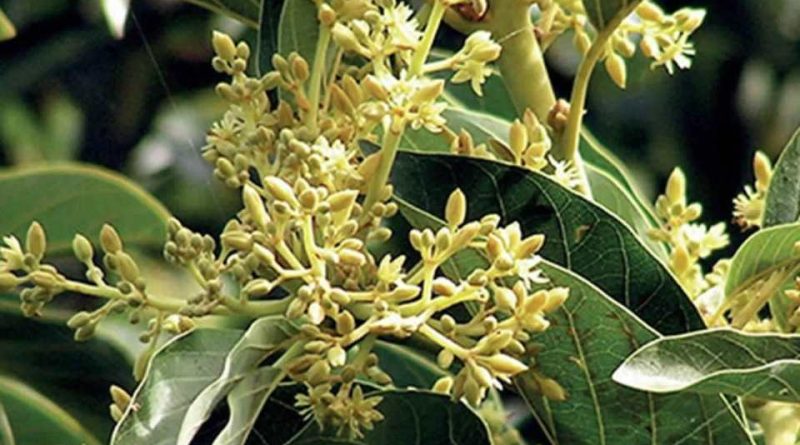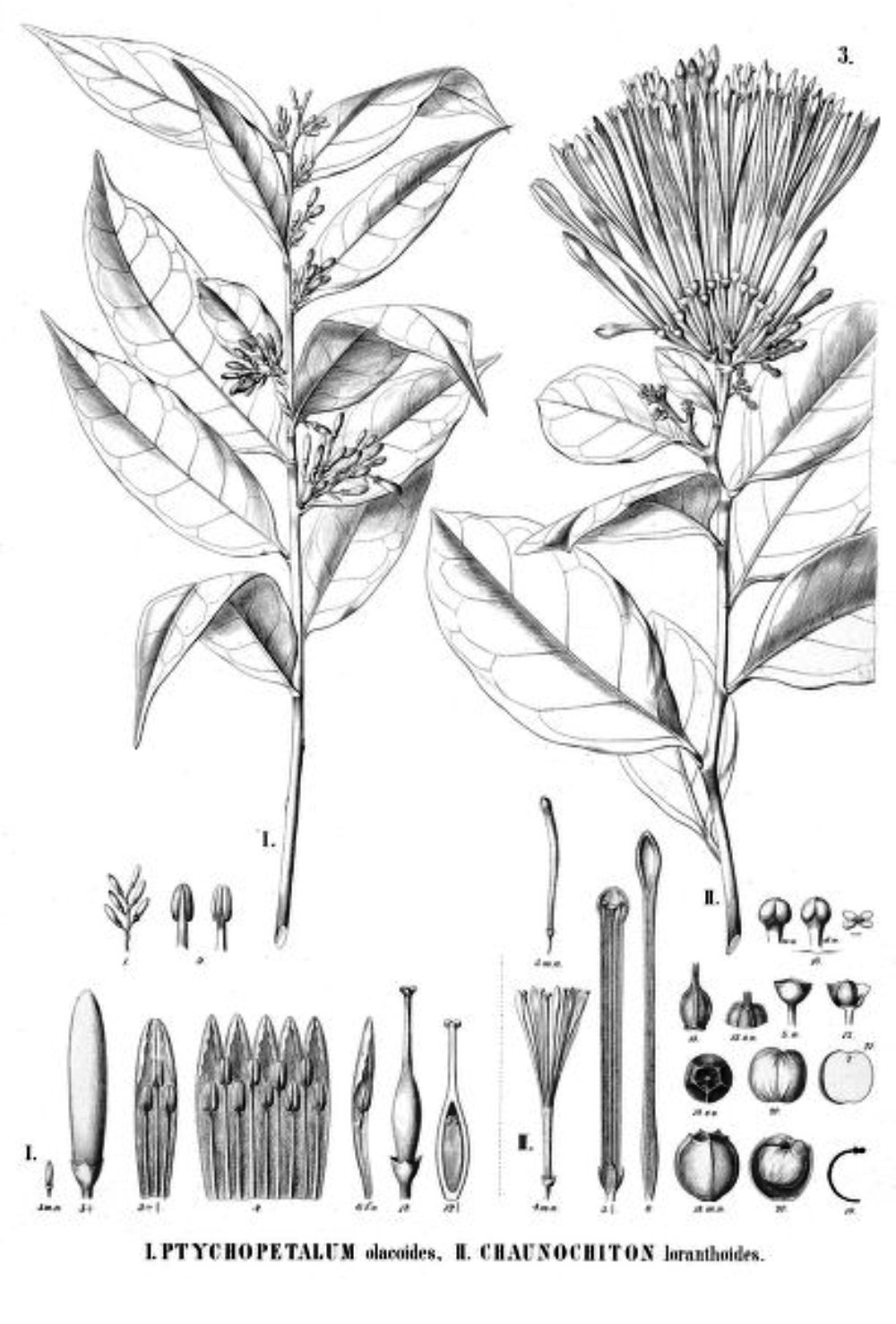Ptychopetalum olacoides
Ptychopetalum olacoides
Muira Puama (Ptychopetalum olacoides Benth.) is an arboreal species belonging to the Olacaceae family.
Systematics –
From a systematic point of view it belongs to:
Eukaryota Domain,
Kingdom Plantae,
Magnoliophyta Division,
Magnoliopsida class,
Subclass Rosidae,
Santalales Order,
Olacaceae family,
Genus Ptychopetalum,
P. olacoides species.
Etymology –
The term Ptycopetalum comes from the ancient Greek πτυχή, ptuch “fold” and πέτᾰλον, pétalon, petal, for the petals with membranous, crenulated margins.
The specific epithet olacoides comes from the genus olax, from the Greek oulos, woolly, which has the characteristics of the Olacaceae.
Geographic Distribution and Habitat –
Ptychopetalum olacoides is a plant native to the northern areas of the Amazon and present in Brazil, Chile and French Guiana.
Its habitat is that of the subtropical areas of the Brazilian Amazon rainforest.
Description –
Ptychopetalum olacoides is a small tree that grows to about 5 meters in height.
The leaves are
about the size of.
The leaves are ovoid in shape, with evident, alternating and opposite veins, thick and darker green on the upper side.
The flowers are small, whitish in color, collected in inflorescences and emanating a pungent scent similar to jasmine. The petals are externally glabrous and internally densely covered for two thirds by a thick down.
The fruits are spherical in shape.
Cultivation –
Muira Puama is a well known and very popular medicinal plant in Brazil that is also becoming more widely used in other areas of the world.
The plant can be grown in soils that retain some humidity but with sufficient drainage.
The suitable climate is those of tropical and subtropical areas but it can grow in other areas provided that winter temperatures do not drop below 0 ° C.
Propagation is ordinarily by seed.
Customs and Traditions –
According to some authors, the name of Muira Puama derives from two Indian words, muyra or muira which means wood or tree and puama, which means strong, powerful. According to others it derives from muyra (or better puyra) which means collar and apuam or puam which means rounded, spherical, allusion to the shape of the fruits that were used by Indian women to make necklaces. (Adorno de pescoço = neck ornament).
It is a small tree well known for its aphrodisiac and invigorating effects.
The ancient tribes attributed exceptional virtues to this plant, and used it for various problems: rheumatism, gastrointestinal problems, but above all in propitiatory rites, mating and fertility.
Many of these uses were adopted by Europeans when they arrived in South America and have subsequently been verified by modern research. The plant is commonly used in many areas of South America, and this use is spreading to other areas of the world.
The ancient native tribes attributed fantastic properties to this plant, calling it the herb of love and using it in many propitiatory mating ceremonies. The first European explorers, in the 1920-1930s, observed that the indigenous people of the Amazon used Muira puama to treat multiple diseases. Once brought to Europe, this plant became part of English herbal medicine and is included in the British Herbal Pharmacopoeia, an authoritative source of English herbal medicine, where it is recommended for the treatment of both impotence and dysentery.
In fact, its use in the West dates back to the early nineteenth century, and its use is closely linked to the sexual sphere.
The parts of the plant used are used for various problems relating to the central nervous system.
The roots and occasionally the bark are the main medicinal parts used and are prepared as alcoholic infusions, tinctures and teas.
Phytochemical studies have revealed that the roots contain tannins, flavonoids and several terpenoids, while the presence of alkaloids is unclear. Most of the studies have used ethanolic or hydroalcoholic extracts prepared from the roots of the plant. These studies indicate that the species has potential uses for the treatment of central nervous system disorders, acting as an antidepressant, stress reliever, neuroprotective agent and improving cognition. Although some herbal products contain P. olacoides in their composition, clinical studies are still needed to confirm the effects observed in the still experimental studies.
The main plant chemicals present in this plant are:
– alpha-copaene, alpha-elemene, alpha-guaiene, alpha-umulene, alpha-muurolene, alpha-pinene, alpha-resinic acid, alpha-terpinene, arachidic acid, allo-aromadendren, behenic acid, beta-bisabolen, beta- caryophyllene, beta-pinene, beta-resinic acid, beta-sitosterol, beta-transfarnesene, borneol, campesterols, camphene, camphor, car-3-ene, caryophyllene, cerotic acid, chromium, coumarin, cubebene, delta-cadinene, dotriacontanoic acid , elixene, ergosterols, eugenol, essential oils, gamma-muurolene, entriacontanoic acid, heptacosanoic acid, lignoceric acid, limonene, linalool, lupeol, melissic acid, montanic acid, muirapuamine, myrcene, nonacosanoic acid, para-cymene, pentbafacosanoic acid , stigmasterols, trichosanic acid and uncosanic acid.
One of the first studies on the plant showed that muira puama was effective in the treatment of nervous system disorders and sexual impotence and that “the permanent effect is produced in locomotor ataxia, long-standing neuralgia, chronic rheumatism and in partial paralysis “.
The benefits of impotence treatment with muira puama were studied in two human studies in France, which reported that muira puama was effective in improving libido and treating erectile dysfunction.
In another study, muira puama extracts were reported to have adaptogenic, anti-fatigue, anti-stress and central nervous system benefits.
In Brazil, researchers have documented a definite effect of the cortex on the central nervous system.
The cortex also demonstrated a mild, short-lived hypotensive effect.
The root was also found to inhibit stress-induced ulcers.
The leaves have an analgesic effect.
In 2003, Brazilian researchers reported that an alcoholic extract of muira puama facilitated memory retrieval and noted that it could be useful for Alzheimer’s patients. Their subsequent study, published in 2004, reported that an alcoholic extract of muira puama protected and increased the vitality of brain cells (in part through an antioxidant effect) which may be beneficial for stroke victims.
Preparation Method –
The roots, branches and bark of the young plants of Ptychopetalum olacoides have long been used in traditional medicine as a tonic to treat neuromuscular problems; a decoction of the root is used in baths and massages for the treatment of paralysis and beriberi; while a root and bark tea is taken to treat sexual weakness, rheumatism, flu, and heart and gastrointestinal weakness. The plant is also popular as a prevention of baldness.
In modern herbal medicine, muira puama is a highly regarded sexual stimulant with a reputation as a potent aphrodisiac. It is used as a neuromuscular tonic to treat weakness and paralysis, dyspepsia, menstrual disorders, sexual impotence, flu and central nervous system disorders; it is also applied externally to treat chronic rheumatism.
To get the libido and potency effects of this particular plant, proper preparation methods must be employed. The active constituents believed to be responsible for the potency and libido effect of muira puama are not soluble in water; taking bark or root powder in capsules or tablets will not be effective because these chemicals cannot be digested or absorbed. Therefore, a high heat for at least 20 minutes with alcohol is necessary to release the volatile and essential oils, terpenes, gums and resins present in the bark and root which seem to be responsible for the beneficial effects of muira puama.
In folk medicine, a hydroalcoholic extract was also used, obtained by maceration in a liqueur, such as rum or cognac.
Also in Italy it is mainly marketed in the form of hydroalcoholic extract.
Guido Bissanti
Sources
– Acta Plantarum – Flora of the Italian Regions.
– Wikipedia, the free encyclopedia.
– Useful Tropical Plants Database.
– Conti F., Abbate G., Alessandrini A., Blasi C. (ed.), 2005. An annotated checklist of the Italian vascular flora, Palombi Editore.
– Pignatti S., 1982. Flora of Italy, Edagricole, Bologna.
– Treben M., 2000. Health from the Lord’s Pharmacy, Advice and experiences with medicinal herbs, Ennsthaler Editore.
Warning: Pharmaceutical applications and alimurgical uses are indicated for informational purposes only, they do not represent in any way a medical prescription; therefore no responsibility is taken for their use for curative, aesthetic or food purposes.
Photo source:
– http://legacy.tropicos.org/Image/64355


